| This article may require cleanup to meet Tractor Wiki's quality standards. (Consider using more specific cleanup instructions.) Please help improve this article if you can. The talk page may contain suggestions. |
 | |
| Manufacturer | Willys and Ford |
|---|---|
| Production |
640,000 standardized; 8,690 other (1941–1945) |
| Successor | Willys M38 |
| Body style(s) |
can be piled for shipping, plastic steering wheel, steel seats, hinged passenger front seat, slitted War-time front parking lights. •Gauges: speedo 0 - 60mph, Temp 0 - 220F, Amp +30/-30A, Oil pressure, map light. Failsafe main light switch pushbutton (can't accidentally pull mainlights on). |
| Engine(s) |
4-cyl. side valves, 134 CID (2199 cc), 60 hp. •Other: Oil Filter; oil filled mesh; 1 throat carburettor, manual choke, exhaust/intake at drivers side, intake heated via exhaust/bimetal ctrl spring. 6Volt DC-current generator, Failsafe automatic fuse. |
| Transmission(s) |
3-speed + reverse t-84 transmission 2-speed t-18 transfer case; Transfer case2 selections: 2wd Hi , 4WD Hi, 4WD Lo |
| Wheelbase | 80 inches (203 cm) leaf springs, shock absorbers in all 4; full hydraulic brakes in all 4; handbrake assembly at rear of transfercase |
| Length | 131 inches (333 cm) |
| Width | 62 inches (157.5 cm) |
| Height |
72 inches (183 cm) with top up reducible to 52 inches (132 cm) |
| Curb weight | 2,293 lb(1040 kg) |
| Fuel capacity | 15 U.S. gallons (12 imp gal/57 L) (tank under driver seat);(plus strap-on extra fuel canisters) |
| Related |
Ford GPA 'Seep' Volkswagen Kübelwagen |
| This article needs additional citations for verification. Please help improve this article by adding citations to reliable sources. Unsourced material may be challenged and removed. (March 2009) |
Introduction[]
The Willys MB US Army Jeep, along with the nearly identical Ford GPW, was manufactured from 1941 to 1945. They are the iconic World War II Jeep.
History[]
During World War I there were limited attempts to mechanize military forces. The US Army had already used 4x4 trucks in it, supplied by the Four Wheel Drive Auto Co. (FWD); by the time World War II was dawning, the United States Department of War was still seeking a standardized light cross-country and reconnaissance vehicle.
As tensions were heightening around the world in the late Thirties, the US Army put the word out to American automobile manufacturers to come up with suggestions to replace its existing, aging light motor vehicles, mostly motorcycles and sidecars but also some Ford Model T's.[1][2] This resulted in several prototypes being presented to army officials, like five Marmon-Herrington 4x4 Fords in 1937, and three Austin roadsters by American Bantam in 1938 (Fowler, 1993). However, the US Army's requirements were not formalised until July 11, 1940, when 135 U.S. automotive manufacturers were approached to submit a design conforming to their specifications, for a vehicle the World War II training manual TM 9-803 described as "... a general purpose, personnel, or cargo carrier especially adaptable for reconnaissance or command, and designated as 1/4-ton 4x4 Truck."
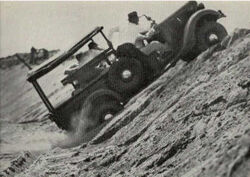
Marmon-Herrington converted Ford 1/2 ton truck, sometimes called the "Grandfather of the Jeep"
By now the war was underway in Europe so the rush was on and the Army's tender was quite demanding. Company's bids were to be received by July 22 (just eleven days later). They were given 49 days to submit their first prototype, and 75 days for completion of 70 required test vehicles. The Army's Ordnance Technical Committee specifications were equally demanding: the vehicle would be four-wheel drive, have a crew of three, on a wheelbase of no more than 75 (later 80) inches and tracks no more than 47 inches, a fold-down windshield, 660 lb payload and be powered by an engine capable of 85 ft·lbf (115 N·m) of torque. The most daunting demand however was an empty weight of no more than 1300 lb (590 kg).
Only three companies entered: American Bantam Car Company, Ford Motor Company and Willys-Overland Motors. Though Willys-Overland was the low bidder, Bantam received the bid, being the only company committing to deliver a pilot model in 49 days and production examples in 75. Under the leadership of designer Karl Probst, Bantam built their first prototype, dubbed the Blitz Buggy (and in retrospect "Old Number One"), and delivered it to the Army vehicle test center at Camp Holabird, Maryland on September 23, 1940. This presented Army officials with the first of what would eventually evolve into the World War II US Army Jeeps: the Willys MB and Ford GPW.
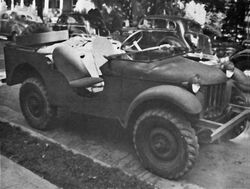
The Bantam no.1 'Blitz Buggy'
Since Bantam did not have the production capacity or fiscal stability to deliver on the scale needed by the War Department, the two losing bidders, Ford and Willys, were encouraged to complete their own pilot models for testing. The contract for the new reconnaissance car was to be determined by trials. As testing of the Bantam prototype took place from September 27 to October 16, Ford and Willys technical representatives present at Holabird were given ample opportunity to study the vehicle's performance. Moreover, in order to expedite production, the War Department forwarded the Bantam blueprints to Ford and Willys, claiming the government owned the design. Bantam did not dispute due to its precarious financial situation. By November 1940 Ford and Willys each submitted prototypes to compete with the Bantam in the Army's trials. The pilot models, the Willys Quad and the Ford Pygmy, turned out very similar to each other and were joined in testing by Bantam's entry, now evolved into a Mark II called the BRC 60. By then the US and its armed forces were already under such pressure, that all three cars were declared acceptable and orders for 1500 units per company were given, for field testing. At this time it was acknowledged the original weight limit (which Bantam had ignored) was unrealistic, and it was raised to 2160 lb (980 kg).
For these respective pre-production runs, each vehicle received revisions and a new name. Bantam's became the BRC 40, and the company ceased motor vehicle production after the last one was built in December 1941. After losing 240 lb, Willys' changed the designation to "MA" for "Military" model "A". The Fords went into production as "GP", with "G" for a "Government" type contract and "P" commonly used by Ford to designate any passenger car with a wheelbase of 80 inches.[3]
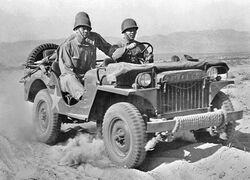
Willys MA jeep at the Desert Training Center, Indio, CA, June 1942
By July 1941, the War Department desired to standardize and decided to select a single manufacturer to supply them with the next order for another 16,000 vehicles. Willys won the contract mostly due to its more powerful engine (the "Go Devil") which soldiers raved about, and its lower cost and silhouette. Whatever better design features the Bantam and Ford entries had were then incorporated into the Willys car, moving it from an "A" designation to "B", thus the "MB" nomenclature. For example, if the gasoline tank was directly beneath the driver's seat, combining the two main target areas into one, it would lessen the chance of a catastrophic hit.
By October 1941, it became apparent Willys-Overland could not keep up with production demand and Ford was contracted to produce them as well. The Ford car was then designated GPW, with the "W" referring to the "Willys" licensed design. During World War II, Willys produced 363,000 Jeeps and Ford some 280,000. Approximately 51,000 were exported to Russia under the Lend-Lease program.
A further 13,000 (roughly) amphibian jeeps were built by Ford under the name GPA (nicknamed 'Seep' for Sea Jeep). Inspired by the larger DUKW, the vehicle was produced too quickly and proved to be too heavy, too unwieldy, and of insufficient freeboard. In spite of participating successfully in the Sicily landings (September 1943) most GPAs were routed to Russia under the Lend-Lease program. The Russians were sufficiently pleased with its ability to cross rivers to develop their own version of it after the war.
Origin of the term "jeep"[]
- Main article: Jeep#Origin_of_the_term_.22jeep.22
One account of the origin of the term "jeep" begins when the prototypes were being proven at military bases. The term "jeep" was used by soldiers for any untried or untested piece of personnel or equipment. In early 1941, Willys-Overland staged a press event in Washington, D.C., having the car demonstrate its prowess by driving up the Capitol steps. Irving "Red" Hausmann, a test driver on the Willys development team, who had accompanied the car for its testing at Camp Holabird, had heard soldiers there referring to it as a jeep. He was enlisted to go to the event and give a demonstration ride to a group of dignitaries, including Katherine Hillyer, a reporter for the Washington Daily News. When asked by the reporter, Hausmann too called it a Jeep. Hillyer's article appeared in the newspaper on February 20, 1941, with a photo showing a jeep going up the Capitol steps and a caption including the term 'jeep'. This is believed to be the most likely cause of the term being fixed in public awareness. Even though Hausmann did not create or invent the word Jeep, he very well could be the one most responsible for its first news media usage.
It has been theorized that the Jeep vehicle was named after Eugene the JEEP : soldiers in World War II may have nicknamed the machine after the then-popular character because they shared an ability to go anywhere
Grille[]
Willys made its first 25,000 MB Jeeps with a welded flat iron "slat" radiator grille. It was Ford who first designed and implemented the now familiar and distinctive stamped, slotted steel grille into its cars, which was lighter, used fewer resources, and was less costly to produce. Along with many other design features innovated by Ford, this was adopted by Willys and implemented into the standard WW II Jeep by April 1942.
Even today, some 65 years later, Jeep's makers proudly retain the historical connection to the visage of their ancestors by using a trademarked grille featuring a standard number of vertical openings or 'slots'. However, in order to be able to get theirs trademarked, Willys gave their post-war jeeps seven slots instead of Ford's nine-slot design. Through a long path of corporate take-overs and the like, AM General Corporation ended up with the rights to use the seven-slot grille as well, which they in turn extended to General Motors when they sold GM the rights to the Hummer name in 1999.
Post-war[]
After the war, Ford unsuccessfully sued Willys for the rights to the term “Jeep," leaving Willys with full rights to the name, following which Willys took its four-wheel drive marvel to the public with its CJ (Civilian Jeep) versions, making these some of the first mass-produced 4x4 civilian vehicles ever.
The first CJs were essentially the same as the MB, except for such alterations as powered windshield wipers, a tailgate (and therefore a side-mounted spare tire), a rear view mirror, and civilian lighting. Also the civilian jeeps had amenities like naugahyde seats, chrome trim, and a variety of colors. Mechanically, a heftier T-90 transmission replaced the Willys' MB's T84 in order to appeal to the originally considered rural buyers demographic.
Before Willys-Overland company was absorbed into other companies over the years (currently called Jeep and part of Chrysler LLC), it supplied the War Department as well as friendly nations with military jeeps for several more decades.
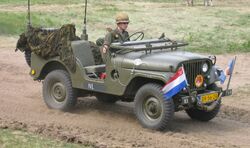
Dutch Army M38A1
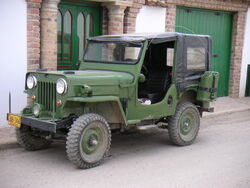
M606 in Colombia
In 1950, the first post-war jeep, the M38 (or MC), was launched, based on the 1949 CJ-3A. In 1953 it was quickly followed by the M38A1 (or MD), featuring an all new "round-fendered" body in order to clear the also new, taller, Willys Hurricane engine. This jeep would later be developed into the CJ-5 launched in 1955. Similarly, its ambulance version, the M170 (or MDA), featuring a 20-inch wheelbase stretch, was later turned into the civilian CJ-6.
Before the CJ-5, Willys offered the public a cheaper alternative with the taller F-head engine in the form of the CJ-3B, a CJ-3A body with a taller hood. This was quickly turned into the M606 jeep (mostly used for export, through 1968) by equipping it with the available heavy-duty options such as larger tires and springs, and by adding black-out lighting, olive drab paint, and a trailer hitch. After 1968, M606A2 and -A3 versions of the CJ-5 were created in a similar way for friendly foreign governments.
Licenses to produce CJ-3Bs were issued to manufacturers in many different countries, and some (like Mahindra in India) continue to produce them in some form or another to this day. The French army for instance produced its Willys MB by buying the Willys license to enable the manufacture of their Hotchkiss M201.
The WWII Jeep inspired many imitations. Creations from competing manufacturers such as Land Rover, Toyota, Nissan, Mitsubishi, Suzuki, and a few others all owe their beginnings in the 4x4 world to the inspiration of the military Jeep.
The compact military jeep continued to be used in the Korean and Vietnam Wars. In Korea, it was mostly deployed in the form of the M38, a direct descendant of the Willys MB. In Vietnam the most used jeep was the then newly designed Ford M151 MUTT, which featured such state-of-the-art technologies as a unibody construction and all around independent suspension with coil-springs. Apart from the mainstream of - by today's standards - relatively small jeeps, an even smaller vehicle was developed for the US Marines, suitable for airlifting and manhandling, the M422 'Mighty Mite'.
Eventually, the US military decided on a fundamentally different concept, choosing a much larger vehicle that would not only take over the role of the jeep, but would also replace all other light military wheeled vehicles, the HMMWV ("Humvee").
In 1991, the Willys-Overland Jeep MB was designated an International Historic Mechanical Engineering Landmark by the American Society of Mechanical Engineers.
Postwar Conversions[]
Starting in 1950, a Jeep-engined utility vehicle was produced by Autoar and from 1951, a rather attractive new sedan appeared, using the same 2199cc Jeep engine and transmission. It was fitted with overdrive to compensate for the Jeep’s low axle ratio. In 1952, a new overhead valve 3-litre six-cylinder was announced, but was probably never built. At that time, Dusio returned to Italy. In the 1950s, production was sporadic, and models built included a station wagon with a Jeep-type 1901cc engine and licensed manufacture of the German NSU Prinz.
In the Philippines[]
"MD Juan" exports 95% of its World War II Willy Jeeps output (1,500 units a year) to collectors mainly in the United States (80%) and Europe (France and the Netherlands, 20%). It was the original four-wheel drive vehicle, the original all-terrain vehicle restored with modern Toyota, Isuzu or carefully-restored original jeep engines, with tag price $ 30,000 at e-Bay auction. The US produced 600,000 jeeps during World War II, and Filipinos used these US surplus jeeps as sole transport available then. Maximiano D. Juan, the 1966 founder of MD Juan, specialize in replicas of these jeeps.[4]
Production[]
| Model | Year(s) | Production |
|---|---|---|
| Bantam pilot | 1940 | 1 |
| Bantam Mk II / BRC-60 | 1940 | 70 |
| Ford Pygmy | 1940 | 1 |
| Ford Budd | 1940 | 1 |
| Willys Quad | 1940 | 5 |
| Bantam BRC-40 | 1941 | 2,605 |
| Ford GP | 1941 | 4,456 |
| Willys MA | 1941 | 1,553 |
| Willys MB | 1942–1945 | 361,339 (335,531 + 25,808 'slats') |
| Ford GPW | 1942–1945 | 277,896 |
| WW II Total | 1940–1945 | 647,925 |
| OTHER | ||
| Ford GPA 'Seep' | 1942–1943 | 12,778 |
| POST-WAR | ||
| Willys M38 (MC) | 1950–1952 | 61,423 |
| Willys M38A1 (MD) | 1952–1957 | 101,488 |
| Willys M606 (CJ-3B) | 1953–1968 | ? (part of 155,494 CJ-3B's produced) |
| Willys M170 | 1954–1964 | 6,500 |
Preservation[]
A number of the original Willys MB Jeeps and the Ford & Hotckiss version are seen at UK shows with displays of military and classic vehicles.
Template:PML Willys Jeep
See also[]
- Military vehicles
- Land Rover
- Willys
- Ford GPA Amphibious Jeep
- VW Type 82 Kübelwagen
- VW Type 128 & 166 Schwimmwagen
- M151 MUTT 'Vietnam Jeep'
- M422 Mighty Mite
- Light Utility Vehicle
- G-numbers (G503)
- Jeep trailer
- List of U.S military vehicles by model number
- collector & preservation related
References / sources[]
Based on the wikipedia article (June 2009)
- ↑ Links4Jeeps.com :: View topic - The History of Jeep
- ↑ DIFFLOCK.com - Jeep 60
- ↑ Ford's GP designation did not represent "general purpose"; that was a government description.
- ↑ Afp.google.com, Philippine firm brings old WWII jeeps back to life
Further reading[]
- The American Society of Mechanical Engineers: The JEEP MB, An International Historic Mechanical Engineering Landmark, Jeep House, Toledo (Ohio) 1991, code H152 (No ISBN)
- Fowler, Will: Jeep Goes to War, Courage Books, Philadelphia (Pa) 1993, ISBN 1-56138-235-3
External links[]
- The History of... Jeeps in Olive Drab - a History of the GI Jeep
- Ford GPW Willys MB Jeep WW2 Trailers
- Bantam jeep story
- Bantam jeep at 42fordgpw.com
- Everything About G503 by GJ
- http://www.cj3a.info/v35/index.html V-35 radio jeep
| ||||||||||||||||||||||||||||||||||||||||
| This page uses some content from Wikipedia. The original article was at Willys MB. The list of authors can be seen in the page history. As with Tractor & Construction Plant Wiki, the text of Wikipedia is available under the Creative Commons by Attribution License and/or GNU Free Documentation License. Please check page history for when the original article was copied to Wikia |